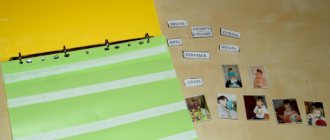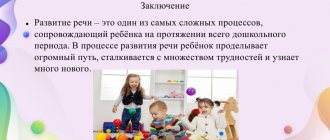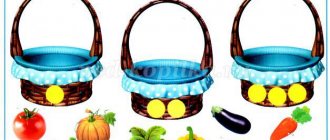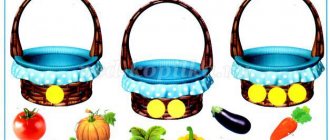Why do you need finger gymnastics?
A set of games and exercises aimed at developing fingers, fine motor skills of the arms, hands, and psychological processes is represented by finger gymnastics. Classes relax, prepare you for school, improve communication with peers, and distract you from unpleasant moments. On the pads of children's fingers there are many nerve endings, the stimulation of which leads to the activation of brain activity. It has been proven that gymnastics and massage affect the development of speech, psychological processes, and writing skills.
Gymnastics goals for children of primary preschool age (1.5-3 years):
- child speech development;
- stimulation, training of the articulatory apparatus;
- developing the skill of tracking an object;
- development of psychological processes;
- rhythm training;
- improving coordination of movements;
- practicing the skill of correctly repeating the actions of other people.
In middle preschool age (4-5 years), gymnastics allows you to:
- relax tension in the muscles of the arm and hand;
- form psychological processes;
- improve fine motor skills of the hands;
- develop involuntary attention;
- stimulate the speaking process, enrich the child’s vocabulary.
For older preschoolers (5-6 years old), finger games help:
- prepare the child for school;
- stimulate cognitive activity;
- develop fine motor skills of the hands, which has a positive effect on preparation for writing;
- enrich the child’s vocabulary;
- develop the creative abilities of the baby.
Exercise for the mind
Starting the day with exercise is a healthy habit and a good tradition. And hand exercises will contribute to the development of intelligence. Do the exercises with your child.
Warm-up
1. Clench your fingers into a fist, then unclench. First with both hands simultaneously, then alternately with the right and left.
2. Make circular movements with your brushes in different directions. Simultaneously and in turn.
3. Interlace your fingers and squeeze into a “lock.”
4. Squeeze your palms and spread your fingers in different directions - you get “sun rays”.
5. “Scissors”: spread your fingers apart and bring them together. First with one hand, then with two.
6. “Fingers say hello”: the pads of the fingers alternately touch the thumb. First on the right hand, then on the left.
7. Pat and tap the table first with your palms, then with your fingers.
8. Place your palms on the table and alternately raise and lower your fingers.
9. Place a small ball on the table and play “football” with your fingers.
10. “Run” your fingers across the table. For example, along a “track” with numbers. To do this, draw circles on a piece of paper with numbers inside from 1 to 10 at a distance of one “step” with your fingers.
Massage
1. Rub your palms.
2. Connect the fingers of your right and left hands and press them firmly against each other 4 times.
3. Rub the palm of one hand over the side of the other hand.
4. Take a pencil and roll it between your palms.
5. Take a walnut and roll it in your palms.
Then you can move on to pressing “problems”: fastening a zipper or buttons, tying bows or laces.
Visual aids for the development of fine motor skills can be purchased at the store, or you can make them yourself. For example, on a rug in the shape of a turtle you can place buttons, zippers, buttons, fasteners, buckles, and laces.
How to properly exercise with your baby
Finger exercises for the development of speech and thinking can be done at home. The work will be easier for the baby in the presence of a loved one. Sometimes preschoolers are afraid to make the wrong movement with their hands, to complete the task incorrectly, so they work inactively during gymnastics in kindergarten. It is important to do gymnastics at home, taking into account the age characteristics of the child.
Complex for children from one to 3 years old
Finger exercises and games are especially useful for children of primary preschool age. Classes contribute to the active formation and launch of speech. Kids like to repeat the movements of adults; they listen carefully to the rhymes and songs that accompany the exercises. You can use a special speech therapy file in the game.
When conducting home exercises, you must follow the following rules:
- For children of primary preschool age, the first lessons should last no more than 1 minute, then 3-5 minutes each.
- The parent should praise the child for his successes and not scold him if he repeats the adult incorrectly.
- To make the games fun and interesting, you should use finger exercises that correspond to the age characteristics of the baby.
- For games, it is important to use songs and rhymes that the child could then repeat after an adult; they should be small and easy to understand.
- Exercises should be selected according to the degree of difficulty: start with simple ones, moving on to more complex ones.
The following complex develops the child’s speech, psychological processes, and fine motor skills of the hands.
Complex for children 4-5 years old
Gymnastics in middle preschool age is important for speech development; during this period, the baby begins to actively speak and expand his vocabulary. Normally, by the age of 4, a child should know up to 3,000 words, actively use them in conversations with adults and peers, and construct sentences correctly. Children aged 4-5 years involuntarily try to memorize poems and songs that accompany finger games, which stimulates the development of mental processes. In middle preschool age, finger gymnastics helps to correlate a word with an action, relieves tension after modeling or drawing.
Middle-aged preschoolers like exercises where they need to sing a song, learn a rhyme, and repeat after an adult. In kindergarten, during play, special attention is paid to how the baby listens and perceives the task and remembers it. The following materials can be used to conduct classes:
- cards with objects, natural phenomena, figures, etc.;
- diagrams or pictures with finger movements drawn;
- illustrations mentioned in the rhyme: animals, clothes, furniture, etc.;
- presentations to recreate a visual image.
Speech development will be facilitated by exercises where the child will need to repeat movements and words after an adult. Children 4-5 years old like to play shadow theater when they need to depict animals or plants. You can stage small productions with the children based on the fairy tale you have studied.
Complex for children 5-6 years old
Playing finger games and doing gymnastics with children of senior school age is useful as preparation for school. It is easier to master writing if fine motor skills are actively developed at home and at school. It is difficult for first-graders to relax the muscles of their hands and fingers, which provokes difficulties in writing simple calligraphic elements.
You can play with preschoolers, relying on the knowledge acquired in kindergarten: counting, colors, shapes, etc. Children like the finger game “Twister”, when you need to place your fingertips on the color that appears in the cubes. To play you will need 2 cubes, one with a color palette, the second indicating the desired finger, a multi-colored sheet in the form of circles. You can arrange competitions, study together with your parents or peers.
Exercises are used for the active work of individual fingers and their joints.
When working with older preschoolers, you can use not only exercises and games, but also special massage balls. They train the muscles of the hand and relax it. It is important to roll the object not only on the palm, but also separately on each finger, connecting them together with a ball.
It is important to observe the time frame and combination of exercises when working with children of any age. To make the process of learning and development easy and interesting for the child, you need to carry out exercises for no more than 5 minutes, alternating them with rest or self-massage of your fingers and palms.
Games and gymnastics are recommended for all preschoolers for all-round development, stimulation of speaking, creative activity, and communication skills. It is especially important to conduct classes at home, not only in a preschool institution, if the child is lagging behind in speech development. Repeated repetition of rhymes and songs during exercises and games leads to their memorization. Later, the child begins to repeat after the adult either individual words or the entire poem.
Games for older children
Don’t rush to once again reprimand your child for “putting his hands where he shouldn’t.” It is better to think about how to organize an environment around the child so that conditions are created for the development of children's abilities.
In a separate corner, collect cones, chestnuts, plastic jars and containers with lids. Let the baby open them, close them, twist them, feel the cones and chestnuts, and put them in containers.
Encourage your child to “work” with sand, clay, and water more often. You can pour or pour sand into different dishes (plastic or metal). Teach your child to use a funnel.
Increasing difficulty
The second level requires more precise, but static actions, thanks to which “S” will be pronounced much easier.
"Stepan's Dream"
For each line of the poem it is necessary to make movements of the fingers, lips or tongue. Children must recite the verse.
Stepan has a sweet dream (children cover their eyes with their hands)
Sees fresh sour cream (open eyes wide and lick lips in a circular motion of the tongue clockwise)
In a familiar blue bowl (the palms of both hands need to be joined so that a depression is formed - we represent a bowl)
And he has a spoon with him (now the bowl is represented by one bent palm, and the protruding index finger of the other hand is a spoon. The child makes circular movements of the thumb along the “palm-bowl”).
He eats sour cream with a spoon (his thumb “scoops up” imaginary sour cream and brings it to his mouth. You can imitate chewing movements).
Stepan dreams of all this (they cover their eyes with their palms again).
Seed to grain
Classes to develop fine motor skills can include exercise games with cereals, legumes, and seeds. Bulk products can be distributed in an even layer on a tray and invite the child to draw patterns and objects on it with his fingers. “Drawing” can be accompanied by poetry.
In the morning the sun woke up,
It reached out carefully.
It's time for the rays to rise,
One two three four five.
The flag is burning in the sun, as if I had lit a fire.
She lives in the water, has no beak, but pecks.
You can also use cereal to lay out shapes along the contour. You can draw any object and ask your child to line it with beans, peas or buckwheat grains. The smaller the grain, the more difficult it is to complete the task.
Before working with your child, you need to prepare with him all the material necessary for the task. Be sure to ask your child to tell you what happened and analyze your actions.







